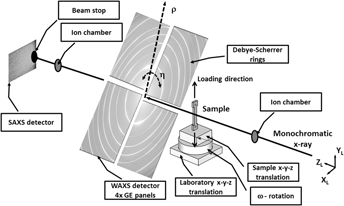Crossref Citations
This article has been cited by the following publications. This list is generated based on data provided by
Crossref.
Hoelzer, D.T.
Unocic, K.A.
Sokolov, M.A.
and
Byun, T.S.
2016.
Influence of processing on the microstructure and mechanical properties of 14YWT.
Journal of Nuclear Materials,
Vol. 471,
Issue. ,
p.
251.
Zhang, Xuan
Park, Jun-Sang
Almer, Jonathan
and
Li, Meimei
2016.
Characterization of neutron-irradiated HT-UPS steel by high-energy X-ray diffraction microscopy.
Journal of Nuclear Materials,
Vol. 471,
Issue. ,
p.
280.
Lin, Jun-Li
Mo, Kun
Yun, Di
Miao, Yinbin
Liu, Xiang
Zhao, Huijuan
Hoelzer, David T.
Park, Jun-Sang
Almer, Jonathan
Zhang, Guangming
Zhou, Zhangjian
Stubbins, James F.
and
Yacout, Abdellatif M.
2016.
In situ synchrotron tensile investigations on 14YWT, MA957, and 9-Cr ODS alloys.
Journal of Nuclear Materials,
Vol. 471,
Issue. ,
p.
289.
Zhang, Xuan
Li, Meimei
Park, Jun-Sang
Kenesei, Peter
Almer, Jonathan
Xu, Chi
and
Stubbins, James F.
2017.
In situ high-energy X-ray diffraction study of tensile deformation of neutron-irradiated polycrystalline Fe-9%Cr alloy.
Acta Materialia,
Vol. 126,
Issue. ,
p.
67.
Zhang, Xuan
Xu, Chi
Wang, Leyun
Chen, Yiren
Li, Meimei
Almer, Jonathan D.
Benda, Erika
Kenesei, Peter
Mashayekhi, Ali
Park, Jun-Sang
and
Westferro, Frank J.
2017.
iRadMat: A thermo-mechanical testing system for in situ high-energy X-ray characterization of radioactive specimens.
Review of Scientific Instruments,
Vol. 88,
Issue. 1,
Park, Jun-Sang
Zhang, Xuan
Kenesei, Peter
Wong, Su Leen
Li, Meimei
and
Almer, Jonathan
2017.
Far-Field High-Energy Diffraction Microscopy: A Non-Destructive Tool for Characterizing the Microstructure and Micromechanical State of Polycrystalline Materials.
Microscopy Today,
Vol. 25,
Issue. 5,
p.
36.
Degueldre, Claude André
2017.
The Analysis of Nuclear Materials and Their Environments.
p.
35.
Guillen, Donna Post
Pagan, Darren C.
Getto, Elizabeth M.
and
Wharry, Janelle P.
2018.
In situ tensile study of PM-HIP and wrought 316 L stainless steel and Inconel 625 alloys with high energy diffraction microscopy.
Materials Science and Engineering: A,
Vol. 738,
Issue. ,
p.
380.
Zhang, Xuan
Li, Meimei
Park, Jun-Sang
Kenesei, Peter
Sharma, Hemant
and
Almer, Jonathan
2018.
High-energy x-ray diffraction microscopy study of deformation microstructures in neutron-irradiated polycrystalline Fe-9%Cr.
Journal of Nuclear Materials,
Vol. 508,
Issue. ,
p.
556.
Seol, Jae Bok
Haley, Daniel
Hoelzer, David T.
and
Kim, Jeoung Han
2018.
Influences of interstitial and extrusion temperature on grain boundary segregation, Y−Ti−O nanofeatures, and mechanical properties of ferritic steels.
Acta Materialia,
Vol. 153,
Issue. ,
p.
71.
Blaiszik, Ben
Chard, Kyle
Chard, Ryan
Foster, Ian
and
Ward, Logan
2019.
Data automation at light sources.
Vol. 2054,
Issue. ,
p.
020003.
Imseeh, Wadi H.
Alshibli, Khalid A.
Moslehy, Amirsalar
Kenesei, Peter
and
Sharma, Hemant
2020.
Influence of crystal structure on constitutive anisotropy of silica sand at particle-scale.
Computers and Geotechnics,
Vol. 126,
Issue. ,
p.
103718.
Nori, Sri Tapaswi
Park, Gyuchul
Williams, Walter
Lee, Zhengrong
Warren, Mark
Terry, Jeff
Park, Jun-Sang
Kenesei, Peter
Almer, Jonathan
and
Okuniewski, Maria A.
2021.
Revealing the chemical environment of Cr, Fe, and Ni in high temperature-ultrafine precipitate strengthened steel subjected to low fluence neutron irradiation.
Journal of Nuclear Materials,
Vol. 554,
Issue. ,
p.
153056.
Oh, Seunghee A.
Lim, Rachel E.
Aroh, Joseph W.
Chuang, Andrew C.
Gould, Benjamin J.
Bernier, Joel V.
Parab, Niranjan
Sun, Tao
Suter, Robert M.
and
Rollett, Anthony D.
2021.
Microscale Observation via High-Speed X-ray Diffraction of Alloy 718 During In Situ Laser Melting.
JOM,
Vol. 73,
Issue. 1,
p.
212.
Wang, Jie
Zhu, Gaoming
Wang, Leyun
Vasilev, Evgenii
Park, Jun-Sang
Sha, Gang
Zeng, Xiaoqin
and
Knezevic, Marko
2021.
Origins of high ductility exhibited by an extruded magnesium alloy Mg-1.8Zn-0.2Ca: Experiments and crystal plasticity modeling.
Journal of Materials Science & Technology,
Vol. 84,
Issue. ,
p.
27.
Park, Jun-Sang
Sharma, Hemant
and
Kenesei, Peter
2021.
Repeatability and sensitivity characterization of the far-field high-energy diffraction microscopy instrument at the Advanced Photon Source.
Journal of Synchrotron Radiation,
Vol. 28,
Issue. 6,
p.
1786.
Connolly, M.J.
Park, J-S.
Almer, J.
Martin, M.L.
Amaro, R.
Bradley, P.E.
Lauria, D.
and
Slifka, A.J.
2022.
High energy X-ray diffraction and small-angle scattering measurements of hydrogen fatigue damage in AISI 4130 steel.
Journal of Pipeline Science and Engineering,
Vol. 2,
Issue. 3,
p.
100068.
Imseeh, Wadi H.
Alshibli, Khalid A.
Kenesei, Peter
and
Sharma, Hemant
2023.
Multiscale Processes of Instability, Deformation and Fracturing in Geomaterials.
p.
87.
Hurley, Ryan C.
Pagan, Darren C.
Herbold, Eric B.
and
Zhai, Chongpu
2023.
Examining the micromechanics of cementitious composites using In-Situ X-ray measurements.
International Journal of Solids and Structures,
Vol. 267,
Issue. ,
p.
112162.



